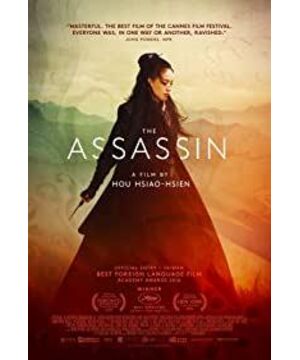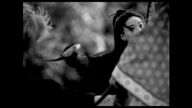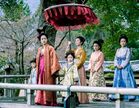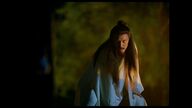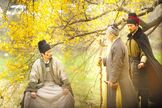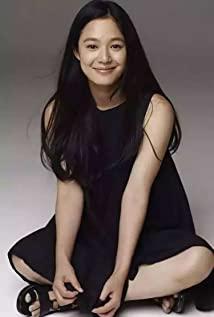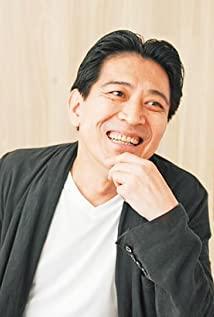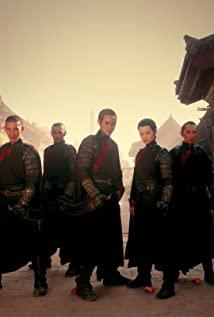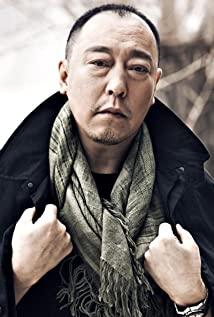At the beginning of "Assassin Nie Yinniang", Nie Yinniang and her master were ambushing the officers by the tree, and the ones they were brushing were not a horse but a donkey. The donkey is a very meaningful image in the movie. What impressed me most was the French film master Robert Bresson's "Balthasar the Donkey", which symbolized a certain simple and pure spirit. Later, I saw the donkey again in Zhang Yimou's "Judou", but it was reduced to eroticism. metaphor. Hou Hsiao-hsien should have the same kind of film writing temperament as Bresson, pursuing an anti-dramatic effect and disliking "acting". Bresson called the characters in the film "human models" to distinguish them from those who performed on stage. The performance was very deliberate to make the audience believe in his motives and what they saw with their eyes. And the most authentic film description is to let the actors naturally show what they want to hide.
As the donkey flashed past, Nie Yinniang rushed into the battle, killing Da Liao with one blow. The shadows and shaking of the leaves and the sun made people feel in the world of Akira Kurosawa's "Rashomon". Akira Kurosawa, the Japanese film emperor, also admired Hou Hsiao-hsien's shooting, believing that he broke through the limitations of the "frame" of photography and allowed people to see the world outside the "frame". This may be the "iceberg" of director Hou Hsiao-hsien that one of the screenwriters of this film, Xie Haimeng, said, but this iceberg, hidden a little deep and exposed to the sea, is a huge historical structure. The blood of Da Liao changed the picture from black and white to color, and there are five kendo-like characters like "Assassin Nie Yinniang" in the style of Hu Jinquan's film title. .
Nie Yinniang was ordered to go down the mountain to assassinate Wei Bo Jiedu, his cousin, Tian Ji'an. The scene changed from a mountain of autumn mountains to a room full of rich colors, which is the color of the Tang Dynasty verified by Hou Hsiao-hsien. It is impossible for film directors to study history more than professional scholars, but they often have a unique vision and can capture the eye-catching details among the complicated rules and regulations. In the midst of the splendid costumes and splendid utensils, I noticed the candles beside Tian Ji'an's couch, which reminded the American director Kubrick during the filming of the epic "Barry Lyndon", in order to ensure the natural light for the indoor scenes The need for lighting, this madman actually bought enough beeswax candles to light up a hundred ballrooms, which were used by European aristocrats. At that time, there was only one company left in the world to produce for the Holy See.
The confrontation between the imperial court and the vassal town, the power struggle within the vassal town, and the love and hatred of the small family constitute the reasonable logic of the assassination theme, which is basically the pattern of the Japanese samurai chapter. In the tormented days of waiting for the release of "Nie Yinniang", I often wondered what would happen if this film was handed over to Yang Dechang. The director of "Guling Street Teenage Murder" must still be like a sharp scalpel. Feeling that Fanzhen is difficult to ride a tiger in the inevitable trend of history, and the individual struggles between the times and the family, and then violently resolves the audience's anxiety with violent conflicts, strong video styles, and releases the adrenal glands. But Yang Dechang died early. Even if he realized the tenderness of "Yiyi" before his death, Hou Hsiao-hsien is still alive and continues to prove to the world the artistic charm of Chinese-language films.
Martial arts film is a genre film that is suitable for reflecting the creator's understanding of traditional Chinese spirit in terms of form and content. It seems that every director will use his exploration and interpretation of it in his mature period as a test of his inner spirit and artistic control." touchstone". Every artist sees the world from different angles and levels. Ang Lee is good at family ethics and filmed "Crouching Tiger, Hidden Dragon". Talking about the fledgling and mid-life crisis is actually talking about a life. The story is best to understand, like stewing a pot of porridge. Yang Dechang, who was still studying for a master's degree in computer science in the United States, shouted "I CAO" after watching German director Wiener Herzog's film and went back to Taiwan to make a film. "Aguirre God's Wrath" represents the rationalism. The crazy spirit of the nation's desperate exploration of the world, Yang Dechang is also thinking about the cruelty and filth of the yellow-skinned population in the reinforced concrete jungle in Taipei, like performing neurosurgery. can come out. What Wong Kar-wai is good at is the concept of time, a cigarette, a look back, hidden flowers at the bottom of the leaves, and snow in a dream. It seems like a dream, like a psychotherapy, but the story is still easy to grasp, remember the timeline.
Hou Hsiao-hsien is a bit like Hu Jinquan, calm and restrained, interpreting their artistic style like Zen. Every frame constructed in Nie Yinniang is like a landscape painting, with the smoke from the morning bell, the mountains and fields, the branches of the hanging beams, the clear sky and the rain, and there is a shadow of a person in the movement and stillness. The motive for the assassination has disappeared between the unfolding of the landscape scroll, and I can no longer grasp the theme and decipher the concept.
The birds go endlessly, and the mountains return to autumn.
As Nie Yinniang's master Taoist said, "kendo has no relatives and does not have the same worries as saints", the camera breaks the artificial narrative logic in the long lens and deep focus, and the content of history disappears in the pure "view". The mountain is the mountain, the water is the water, and the pear flower is the pear flower.
View more about The Assassin reviews


